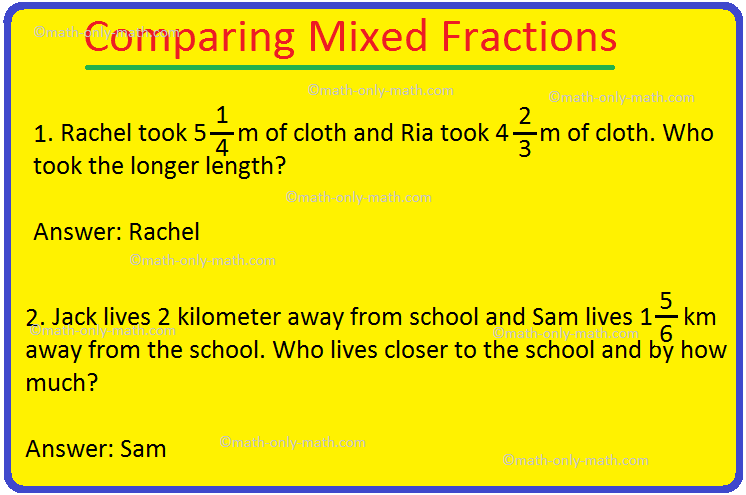Subscribe to our ▶️ YouTube channel 🔴 for the latest videos, updates, and tips.
Comparing Mixed Fractions
YThe fraction with greater whole number part is greater. For example 3\(\frac{1}{2}\) > 2\(\frac{1}{2}\); 4\(\frac{1}{3}\) > 3\(\frac{1}{3}\).
When the whole number parts are equal, we first convert mixed fractions to improper fractions and then compare the two by using cross multiplication method.
Solved example on Comparing Mixed Fractions:
Arrange the fractions \(\frac{4}{15}\), \(\frac{5}{9}\), \(\frac{7}{18}\) and \(\frac{13}{24}\) in ascending order.
Solution:
Prime factors of 15, 9, 18 and 24 are 15 = 3 × 5; 9 = 3 × 3; 18 = 2 × 3 × 3 and 24 = 2 × 2 × 2 × 3
LCM of 15, 9, 18 and 24 is 360
Now, \(\frac{4}{15}\) = \(\frac{4 × 24}{15 × 24}\),
\(\frac{5}{9}\) = \(\frac{5 × 40}{9 × 40}\),
\(\frac{7}{18}\) = \(\frac{7 × 20}{18 × 20}\) and
\(\frac{13}{24}\) = \(\frac{13 × 15}{24 × 15}\)
By comparing the numerators we get \(\frac{96}{360}\), \(\frac{200}{360}\), \(\frac{140}{360}\), \(\frac{195}{360}\);
96 < 140 < 195 < 200
Hence, ascending order is \(\frac{4}{15}\), \(\frac{7}{18}\), \(\frac{13}{24}\) and \(\frac{5}{9}\).
Questions and Answers on Comparing Mixed Fractions:
1. Arrange the given fractions in descending order.
(i) \(\frac{5}{6}\), \(\frac{5}{8}\), \(\frac{5}{4}\)
(ii) 2\(\frac{1}{16}\), 3\(\frac{1}{4}\), 3\(\frac{1}{2}\)
(iii) \(\frac{5}{4}\), \(\frac{3}{12}\), \(\frac{1}{3}\)
(iv) \(\frac{2}{7}\), \(\frac{9}{14}\), \(\frac{11}{14}\)
Answers:
(i) \(\frac{5}{4}\), \(\frac{5}{6}\), \(\frac{5}{8}\)
(ii) 3\(\frac{1}{2}\), 3\(\frac{1}{4}\), 2\(\frac{1}{16}\)
(iii) \(\frac{5}{4}\), \(\frac{1}{3}\), \(\frac{3}{12}\)
(iv) \(\frac{11}{14}\), \(\frac{9}{14}\), \(\frac{2}{7}\)
Word Problems on Comparing Mixed Fractions:
2. Rachel took 5\(\frac{1}{4}\) m of cloth and Ria took 4\(\frac{2}{3}\) m of cloth. Who took the longer length?
Answer: Rachel
3. Jack lives 2 kilometer away from school and Sam lives 1\(\frac{5}{6}\) km away from the school. Who lives closer to the school and by how much?
Answer: Sam
4th Grade Math Activities
From Comparing Mixed Fractions to HOME PAGE
Didn't find what you were looking for? Or want to know more information about Math Only Math. Use this Google Search to find what you need.



New! Comments
Have your say about what you just read! Leave me a comment in the box below. Ask a Question or Answer a Question.